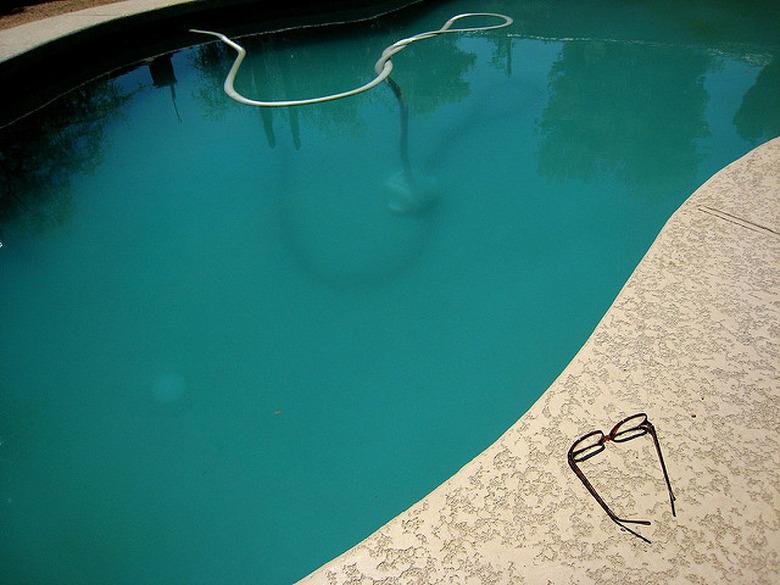Why Is Sand Blowing Out Of A Pool Filter?
If your pool has a sand filter, it goes without saying that the sand should stay in the filter. If you see it blowing out into the pool, something is broken. The most common problem is a cracked lateral, which is one of the perforated pipes at the bottom of the filter that catches water that has circulated through the sand. Whether it's a lateral, the standpipe, or a seal that is worn or broken, you can usually fix the filter yourself, but it may take a few hours.
How a Sand Filter Works
How a Sand Filter Works
A sand filter is basically a large tank filled with pool-grade sand, which is coarser than regular play sand. Water enters the tank through an inlet at the top, and gravity pulls it downward, removing impurities that get lodged in the sand. At the bottom of the tank, the water enters the laterals, which have tiny perforations that keep out the sand. From there, the filtered water circulates back into the pool.
Cracked Laterals: The laterals, a series of six or eight plastic pipes splaying out in a concentric pattern, are critical to the operation of the filter. If any one of them cracks, sand can enter the return pipe and blow back into the pool. The standpipe, which is the vertical pipe connected to the laterals through which water flows back to the pool, can also crack, but because this pipe is made of thicker plastic, it seldom does.
Broken Seal: Sand can also get into the filtered water through the connection between the standpipe and the multi-port connection on the top of the filter. This happens when the O-ring or washer is worn out and must be replaced.
Replacing Broken Parts
Replacing Broken Parts
You have to disassemble the filter before you can replace any internal parts that may be broken, and when you do that, you should replace the sand. Consequently, you'll need a supply of fresh pool sand. The amount depends on the size of the filter, but it's usually between 150 and 350 pounds, or three to seven 50-pound bags. Purchase the sand from a pool supplier to ensure it has the right consistency.
You should also order a full complement of laterals and have those on hand as well before you begin. Consult the owner's manual for the filter to determine how many and what type of laterals you need. You may also need a new washer or O-ring, but it's usually easier to purchase this when you have the old one in hand so you know the exact size you need.
Things Needed
-
Screwdriver
-
Wrench
-
Duct tape
-
Wet/dry vacuum
-
Sand
Step 1
Turn off the water circulation system and drain the filter by unscrewing the plug on the bottom. Wait for water to stop dripping before you proceed.
Step 2
Unscrew and remove the collar holding the multi-port assembly to the top of the filter. Unscrew the unions holding the pipes to the assembly. If there aren't any unions, you'll have to cut the pipes and install unions when you reassemble the filter.
Step 3
Pull off the multi-port assembly; then immediately cover the end of the standpipe with duct tape to prevent sand from getting in. Empty the sand from the filter using a wet/dry vacuum. This could take a while, especially if you have a large filter with a capacity of 350 pounds.
Step 4
Gently lift the standpipe and bend the laterals into a vertical position, so you can pull the manifold out of the filter body. Clean the manifold and look for cracked laterals. Replace any that are cracked. If you aren't sure if a lateral is cracked, it's best to replace it. Check the standpipe for cracks and replace or repair it if you see any.
Step 5
Gently lower the manifold back into the filter body and bend the laterals into a horizontal position. Center the standpipe and fill the filter about half full with clean water. The water prevents damage to the laterals when you pour in the sand.
Step 6
Keep the standpipe centered while you pour in fresh sand. You may need a helper to assist you. When you've finished pouring the sand, remove the tape from the end of the standpipe.
Step 7
Check the O-ring or washer on the bottom of the multi-port assembly and replace it if it's worn. Push the multi-port assembly back onto the standpipe; then secure the collar to hold it to the filter body. Check the washers on each of the unions before screwing them back to the multi-port assembly. Replace any that are worn.
Step 8
Set the filter to backwash and run the pump for two or three minutes to clear the sand of any debris. Set the filter control to rinse and run the pump for another minute or two, or until the water runs clear. Finally, set the control to filter, and the task is complete.
